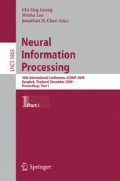Abstract
The role of early sensory neurons is to remove statistical redundancy in the sensory input. In this paper, we propose a novel efficient coding model combining sparse coding strategy and selective attention strategy for image representation. The model is divided into two modules. In the first module, we employ the sparse coding strategy for natural image feature extraction. Furthermore, inspired by the selective attention strategy in biological visual system, we propose a self-adaptive algorithm to further reduce the activated variables in the second module. Compared with standard sparse coding (SC), the experimental results show that the efficient coding model evidently decreases the number of coefficients which may be activated and preserves the main structural information at the same time. Moreover, our model employs fewer responses to preserve similar perceptual image quality than other models.
Access this chapter
Tax calculation will be finalised at checkout
Purchases are for personal use only
Preview
Unable to display preview. Download preview PDF.
References
Barlow, H.B.: Possible principles underlying the transformation of sensory messages. In: Rosenblith, W.A. (ed.) Sensory Communication, pp. 217–234. MIT Press, Cambridge (1961)
Field, D.J.: What is the goal of sensory coding. Neural Computation 6, 559–601 (1994)
Olshausen, B.A., Field, D.J.: Emergence of simple-cell receptive field properties by learning a sparse code for natural images. Nature 381, 607–609 (1996)
Vinje, W.E., Gallant, J.L.: Sparse coding and decorrelation in primary visual cortex during natural vision. Science 287, 1273–1276 (2000)
Grimes, D.B., Rao, R.P.N.: Bilinear sparse coding for invariant vision. Neural Computation 17, 47–73 (2005)
Hoyer, P.O.: Non-negative matrix factorization with sparseness constraints. Journal of Machine Learning Research 5, 1457–1469 (2004)
Hyvarinen, A., Hoyer, P.O.: A two-layer sparse coding model learns simple and complex cell receptive fields and topography from natural images. Vision Research 41, 2413–2423 (2001)
Malo, J., Epifanio, I., Navarro, R., Simoncelli, E.P.: Non-linear image representation for efficient perceptual coding. IEEE Transactions on Image Processing 15, 68–80 (2006)
Wang, Z., Bovik, A.C., Lu, L.: Why is image quality assessment so difficult. In: IEEE Int. Conf. on Acoustics, Speech, and Signal Processing, pp. 3313–3316. IEEE Press, New York (2002)
Wang, Z., Bovik, A.C., Sheikh, H.R., Simoncelli, E.P.: Image quality assessment: from error visibility to structural similarity. IEEE Transactions on Image Processing 13, 600–612 (2004)
Li, Q., Shi, J., Shi, Z.: A model of attention-guided visual sparse coding. In: 4th IEEE Int. Conf. on Cognitive Informatics, pp. 120–125. IEEE Press, New York (2005)
Itti, L., Koch, C., Niebur, E.: A model of saliency-based visual attention for rapid scene analysis. IEEE Transactions on Pattern Analysis and Machine Intelligence 20, 1254–1259 (1998)
Li, Q., Shi, J., Shi, Z.: A selective sparse coding model with embedded attention mechanism. Int’l Journal of Cognitive Informatics and Natural Intelligence 4, 61–74 (2007)
Author information
Authors and Affiliations
Editor information
Editors and Affiliations
Rights and permissions
Copyright information
© 2009 Springer-Verlag Berlin Heidelberg
About this paper
Cite this paper
Li, Z., Shi, Z., Li, Z., Shi, Z. (2009). An Efficient Coding Model for Image Representation. In: Leung, C.S., Lee, M., Chan, J.H. (eds) Neural Information Processing. ICONIP 2009. Lecture Notes in Computer Science, vol 5863. Springer, Berlin, Heidelberg. https://doi.org/10.1007/978-3-642-10677-4_86
Download citation
DOI: https://doi.org/10.1007/978-3-642-10677-4_86
Publisher Name: Springer, Berlin, Heidelberg
Print ISBN: 978-3-642-10676-7
Online ISBN: 978-3-642-10677-4
eBook Packages: Computer ScienceComputer Science (R0)

